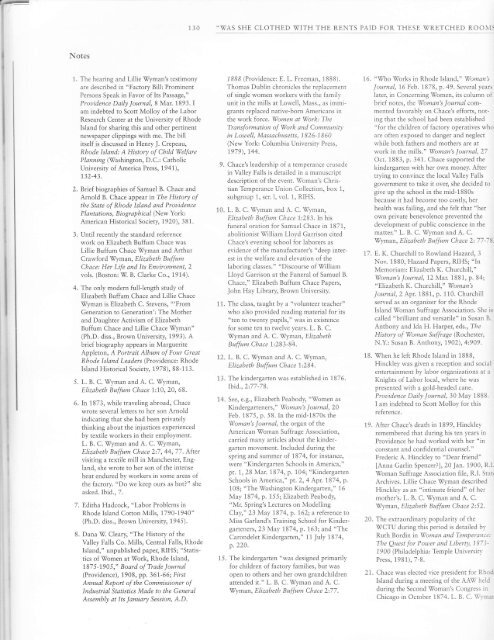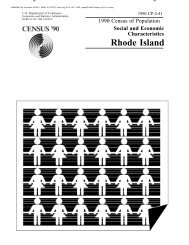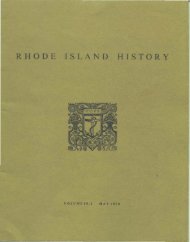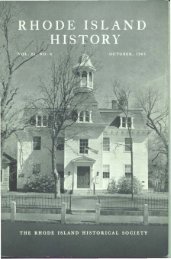Untitled - Rhode Island Historical Society
Untitled - Rhode Island Historical Society
Untitled - Rhode Island Historical Society
Create successful ePaper yourself
Turn your PDF publications into a flip-book with our unique Google optimized e-Paper software.
f,€<br />
Notes<br />
1. The hearing and Lillie Wyman's testrmony<br />
are described in "Factory Bill: Prominent<br />
Persons Speak in Favor of Its Passage,"<br />
Prouidence Daily Journal, B Mar. 1893. I<br />
am indebted to Scott Molloy of the Labor<br />
Research Center at the University of <strong>Rhode</strong><br />
<strong>Island</strong> for sharing this and other pertinent<br />
newspaper clippings with me. The bill<br />
itself is discussed in Henry.|. Crepeau,<br />
<strong>Rhode</strong> <strong>Island</strong>: A History of Child'Welfare<br />
Planning ( Washington, D.C.: Catholic<br />
University of America Press, 1941),<br />
1.32-43.<br />
2. Brief biographies of Samuel B. Chace and<br />
Arnold B. Chace appear inThe History of<br />
the State of <strong>Rhode</strong> <strong>Island</strong> and Prouidence<br />
P I antations, B io grap h ical (New York:<br />
American <strong>Historical</strong> <strong>Society</strong>, 1920), 381.<br />
3. Until recently the standard reference<br />
work on Elizabeth Buffum Chace was<br />
Lillie Buffum Chace'Sfyman and Arthur<br />
Crawford Wyman, Elizabeth Buffum<br />
Chace: Her Life and Its Enuironment,2<br />
vols. (Boston: \X/. B. Clarke Co., 1914).<br />
4. The only modern full-length study of<br />
Elizabeth Buffum Chace and Lillie Chace<br />
'Wyman is Elizabeth C. Stevens, "'From<br />
Generation to Generation': The Mother<br />
and Daughter Activism of Elizabeth<br />
Buffum Chace and Lillie Chace'Wyman"<br />
(Ph.D. diss., Brown University, 1993). A<br />
brief biography appears in Marguerite<br />
Appleton, A Portrait Albwm of Four Great<br />
<strong>Rhode</strong> <strong>Island</strong> Leaders (Providence: <strong>Rhode</strong><br />
<strong>Island</strong> <strong>Historical</strong> <strong>Society</strong>, 1978), 88-1 1 3.<br />
5. L. B. C.'Wyman and A. C.\7yman,<br />
Elizabetb Buffum Chace 1:10,20, 68.<br />
6. In 1873, while traveling abroad, Chace<br />
wrote several letters to her son Arnold<br />
indicating that she had been privately<br />
thinking about the injustices experienced<br />
by textile workers in their employment.<br />
L. B. C. $(/yman and A. C.\fyman,<br />
Elizabeth Buffum Chace 2:7 , 44,77 . After<br />
visiting a textile mill in Manchester, England,<br />
she wrote to her son of the intense<br />
heat endured by workers in some areas of<br />
the factorl'. "Do we keep ours as hot?" she<br />
asked. Ibid., 7.<br />
7. Editha Hadcock, "Labor Problems in<br />
<strong>Rhode</strong> <strong>Island</strong> Cotton Mil1s, L790-1940"<br />
(Ph.D. diss., Brown University, 1945).<br />
8. Dana'W. Cleary, "The History of the<br />
Valley Falls Co. Mills, Central Falls, <strong>Rhode</strong><br />
<strong>Island</strong>," unpublished paper, RIHS; "Statistics<br />
of Women at $fork, <strong>Rhode</strong> <strong>Island</strong>,<br />
1875-1905," Board of Trade Journal<br />
(Providence), 1908, pp. 36L-66; First<br />
Annual Report of the Commissioner of<br />
Industrial Statistics Made to the General<br />
Assembly at lts Janudry Session, A.D.<br />
130 "\ilAS SHE CLOTHED WITH THE RENTS PAID FOR THESE \TRETCHED ROOII!<br />
1888 (Providence: E. L. Freeman,1888).<br />
Thomas Dublin chronicles the replacement<br />
of single women workers with the familv<br />
unit in the mills at Lowell, Mass., as immigrants<br />
replaced native-born Americans in<br />
the work force.'Women at'Vlork: The<br />
Transformation of \York and Communit,t,<br />
in Lowell, Massachusetts, 1826-1 860<br />
(New York: Columbia University Press,<br />
1.979), 144.<br />
9. Chace's leadership of a temperance crusade<br />
in Valley Falls is detailed in a manuscript<br />
description of the event. tWbman's Christian<br />
Temperance Union Collection, box 1,<br />
subgroup 1, ser. 1, vol. 1, RIHS.<br />
10. L. B. C. Wyman and A. C. lWvman,<br />
Elizabetb Buffum Cbace 7:283. In his<br />
funeral oration for Samuel Chace in 1871,<br />
abolitionist \William Lloyd Garrison cited<br />
Chace's evening school for laborers as<br />
evidence of the manufacturer's "deep interest<br />
in the welfare and elevation of the<br />
laboring classes." "Discourse of \Tilliam<br />
Lloyd Garrison at the Funeral of Samuel B.<br />
Chace," Elizabeth Buffum Chace Papers,<br />
John Hay Librar:y, Brown University.<br />
11. The class, taught by a "volunteer teacher"<br />
who also provided reading material for its<br />
"ren ro twenty pupil'." wa\ in eyi\rence<br />
for some ten to twelve years. L. B. C.<br />
'Wyman and A. C. Wyman, Elizabeth<br />
Buffum Chacc l:28 ]-84.<br />
12. L. B. C. Wyman and A. C. !(yman,<br />
Elizabeth Buffum Cbace 1.:284.<br />
13. The kindergarten was established in 1875.<br />
Ibrd.,2:77-78.<br />
14. See, e.g., Elizabeth Peabody, "\(omen as<br />
Kindergarteners,"'V/oman's J otrrnal, 20<br />
Feb. 1875, p. 58. In the mid-1870s the<br />
'Vloman's Jcturnal, the organ of the<br />
American Woman Suffrage Association,<br />
carried many articles abort the kindergarten<br />
movement. included during the<br />
spring and summer of 7874, for instance,<br />
were "l(indergarten Schools in America,"<br />
pt. 1, 28 Mar. 1874, p. 104; "Kindergarten<br />
Schools in America," pt. 2, 4 Apr. 1874, p.<br />
108; "The $Tashington Kindergarten," 16<br />
Ntay 1874, p. 155; Elizabeth Peabody,<br />
"Mr. Spring's Lectures on Modelling<br />
Clay," 23 May 1874,p. 162;a r:eference to<br />
Miss Garland's Training School for Kindergarteners,<br />
23 May 1874,p.153; and "The<br />
Carondelet Kindergarten," 11 July 1874,<br />
n )70<br />
15. The kindergarten "was designed primarily<br />
for children of factory families, but was<br />
open to others and her own grandchildren<br />
attended it." L. B. C. Wyman and A. C.<br />
'$(yman, Elizabeth Buffwm Chace 2:77.<br />
16. "Vho'Works in <strong>Rhode</strong> <strong>Island</strong>," 'Woman's<br />
.lcturnal,16 Feb. 1878, p. 49. Several years<br />
later, in Concerning Women, its column of<br />
brief notes, the'V{oman's Journal commented<br />
favorably on Chace's efforts, noting<br />
that the school had been established<br />
"for the children of factory operatives who<br />
are often exposed to danger and neglect<br />
r,vhile both fathers and mothers are at<br />
work in the mills." 'V/oman's Journal,2T<br />
Oct. 1883, p. 341. Chace supported the<br />
kindergarten with her own money. After<br />
trying to convince the local Valley Falls<br />
government to take it over, she decided to<br />
give up the school in the n'rid-1880s<br />
because it had become too costly, her<br />
health was failing, and she felt that "her<br />
own private benevolence prevented the<br />
development o{ public conscience in the<br />
matter." L. B. C. -J7yman and A.. C.<br />
\(yman, Elizabetb Buffum Chace 2:77-78.<br />
17. E. K. Churchill to Rowland Hazard,3<br />
Nor'. 1880, Hazard Papers, RIHS; "In<br />
Memoriam: Elizabeth K. Churchill,"<br />
'Vloman's Journal, 72 Mar. 1881, p. 84;<br />
"Elizabeth K. Churchill,"'VJoman's<br />
Journal,2 Apr. 1881, p. 110. Churchill<br />
served as an organizer for the <strong>Rhode</strong><br />
<strong>Island</strong> Woman Suffrage Association. She is<br />
called "brilliant and versatile" in Susan B.<br />
Anthony and Ida H. Harper, eds., The<br />
History of Woman Sttffrage (Rochester,<br />
N.Y: Susan B. Anthony, 1902),4:909.<br />
18. \fhen he left <strong>Rhode</strong> <strong>Island</strong> in 1888,<br />
Hinckley was given a reception and sociai<br />
enferrainmenr by labor organi/alion\ at l<br />
Knights of Labor local, where he was<br />
presented with a gold-headed cane.<br />
Prouidence Daily Journal,30 May 1888.<br />
I am indebted to Scott Molloy for this<br />
reference.<br />
19. After Chace's death in 1899, Hinckley<br />
remembered that during his ten years in<br />
Providence he had worked with her "in<br />
constant and confidential counsel."<br />
Frederic A. Hinckley to "Dear friend"<br />
fAnna Garlin Spencer?], 20 Jan. 1900. R.l.<br />
'Woman Suffrage Association file, R.L Sta:,<br />
Archives. l"jllie Chace $fyman described<br />
Hinckley as an "intimate {riend" of her<br />
mother's. L. B. C. \(yman and A. C.<br />
\fyman, Elizabeth Buffum Cbace 2:52.<br />
20. The extraordinary popularity of the<br />
'WCTU<br />
during this period is detailed br<br />
R.uth Bordin in Wctman and Temperanct:<br />
The Quest for Power and Liberty, 1873-<br />
1 900 (Philadelphia: Temple Universin'<br />
Press,1981),7-8.<br />
21. Chace was elected vice president for Rh,::<br />
<strong>Island</strong> during a meeting of the AA\{- he,.<br />
during the Second'Woman's Congress :::<br />
Chicago in October 1.874. L. B. C. \Ir::::i











